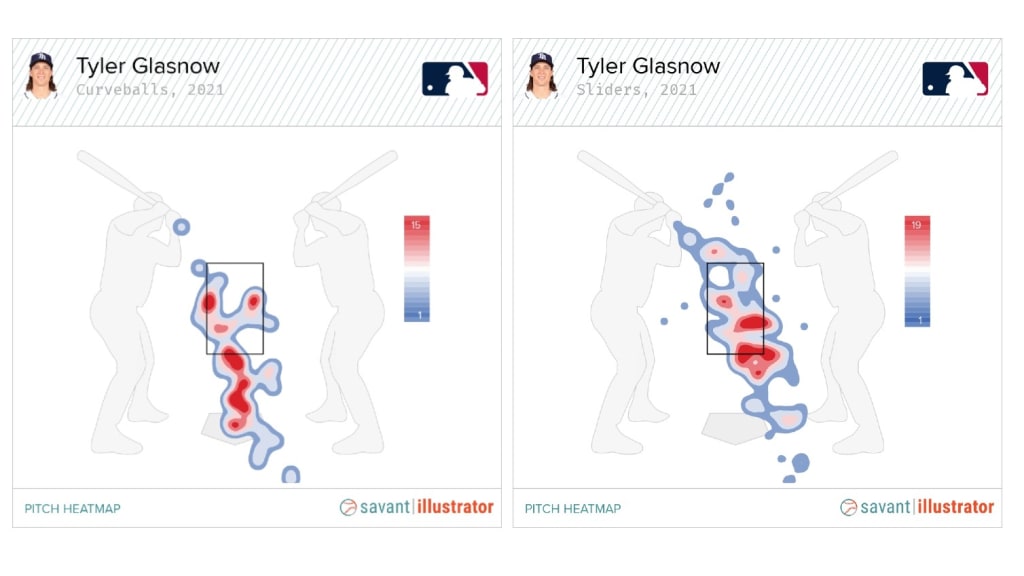Facing Tyler Glasnow was tough enough when he was only throwing fastballs and curveballs. Now that he’s added a new weapon to his arsenal, the Rays right-hander is just unfair.
Heading into his fifth start of the season Friday night against the Blue Jays, Glasnow owns a 0.73 ERA with just nine hits allowed and 36 strikeouts over 24 2/3 innings in 2021, and his pitch usage rates look quite different than they did in the past two years, with a slider now part of the mix.
2019-20
Four-seam fastball: 63.8%
Curveball: 32.1%
Changeup: 4.1%
2021
Four-seam fastball: 57.5%
Slider: 29.1%
Curveball: 12.3%
Changeup: 1.0%
It’s not like the 27-year-old really needed another pitch. Only two starters allowed a lower OPS (.591) than Glasnow across 2019-20.
But Glasnow is taking his dominance to a new level this season. He's held hitters to a .310 OPS, and his 1.26 expected ERA -- based on quality of contact, strikeouts and walks -- is among the lowest marks in the Majors.
The altered pitch mix appears to be a big reason why the 6-foot-8 righty has been so successful.
Glasnow’s slider: Another swing-and-miss pitch
From a pure numbers standpoint, Glasnow’s slider has been a stellar addition.
In 18 plate appearances ending on sliders, hitters have gone 3-for-17 (.176) with four strikeouts. He’s generated a 39.0% whiff rate (misses / swings) with the pitch, putting him several ticks above the 35.5% MLB average whiff rate on sliders.
What’s more important, though, is what the new pitch is doing for his other offerings.
Glasnow’s four-seamer: Most valuable pitch in baseball?
It’s no secret that Glasnow can bring the heat. He’s tied with Gerrit Cole for the fourth-highest average four-seam fastball velocity (97.0 mph) among starting pitchers since the beginning of 2019 (minimum 500 four-seamers).
Glasnow’s four-seamer obviously has been effective, as he’s been able to excel despite relying almost entirely on two pitches in the past two seasons. But his heater has never looked this good.
His four-seamer is tied with Corbin Burnes’ cutter for the best run value of any pitch in MLB.
Best run value, 2021
Tyler Glasnow’s four-seamer: -8
Corbin Burnes’ cutter: -8
Zach Eflin’s sinker: -7
Trevor Bauer’s four-seamer: -6
Joe Musgrove’s slider: -6
Carlos Rodón’s four-seamer: -6
Steven Matz’s sinker: -6
Glasnow's 33.6% whiff rate on four-seamers is more than 10 percentage points higher than it was in 2019-20. He’s had an even larger increase on four-seamers in the strike zone -- a 31.9% whiff rate this year, compared to a 19.1% mark in 2019-20.
In addition, he is doing a much better job of limiting the damage on four-seamer contact. Across 2019-20, opponents slugged close to .400 and hit 11 homers against his four-seam fastball. He hasn’t served up a single round-tripper on any pitch this season, and hitters are 3-for-37 (.081) with 16 strikeouts and a .108 slugging percentage against his four-seamer.
So what’s the reason for this improvement? With Glasnow’s velocity readings and spin rate not changing much from last year, it’s fair to give at least some credit to his altered repertoire.
Previously, hitters only had to worry about two pitches when they faced Glasnow, and they had a good chance of seeing fastballs early in counts. He threw a four-seamer 71.0% of the time on the first or second pitch of a plate appearance in 2019-20. On the first or second pitch this year, Glasnow has thrown a fastball 55.2% of the time. He's gone to his slider 40.8% of the time in these counts.
Glasnow’s curveball: The two-strike hammer
Glasnow’s 12-6 curveball is one of the most devastating pitches in baseball, holding opponents to a .139 average (26-for-189) and a .217 slugging percentage since the beginning of 2019. He’s generated a 48.9% whiff rate on curveballs in that time.
Typically, using a pitch like that less frequently wouldn’t be advisable. The reason it hasn’t hurt Glasnow? His slider is essentially another version of his curve. Both pitches have sharp vertical drop but little horizontal break. The main difference is that he throws his slider 4.0 mph faster on average, and it doesn’t drop quite as much.
Glasnow’s curveball has dropped 57.1 inches on average this season, or 5.9 inches more drop than similar MLB curveballs at his velocity, and he likes to bury the pitch in the dirt. There aren’t many pitches that have been thrown at a lower average height than Glasnow’s curveball (1.21 feet) in 2021.
Basically, what he is doing with his slider is bridging the gap between his four-seamer and curve, both in velocity and location. His average slider location is nearly a foot higher (2.08 feet) than his curveball, and his four-seamer location (2.71 feet) is more than six inches higher than that.

It’s hard enough to tell Glasnow's two breaking balls apart from the viewer’s perspective. Now think how tough it is for a hitter.
In the past, Glasnow didn't hesitate to go to his curveball early in counts, but he has limited its exposure this season. Of the 47 curves he’s thrown this year, 41 have come with two strikes (87.2%).
While it's uncertain if this new usage pattern is the cause, his curveball has been tougher to lay off with two strikes, as evidenced by his 61.0% swing rate on two-strike curves in 2021 (53.9% swing rate on two-strike curves in ’19-20). His putaway rate -- strikeouts per two-strike pitches thrown -- on curveballs is also up, from 34.9% in 2019-20 to 39.0%, one of the highest marks for any specific pitch in the game this year.
Even this early in the season, it’s clear this is a different version of Glasnow than we’ve seen in the past. And that’s bad news for hitters who have to step into the box against him.
